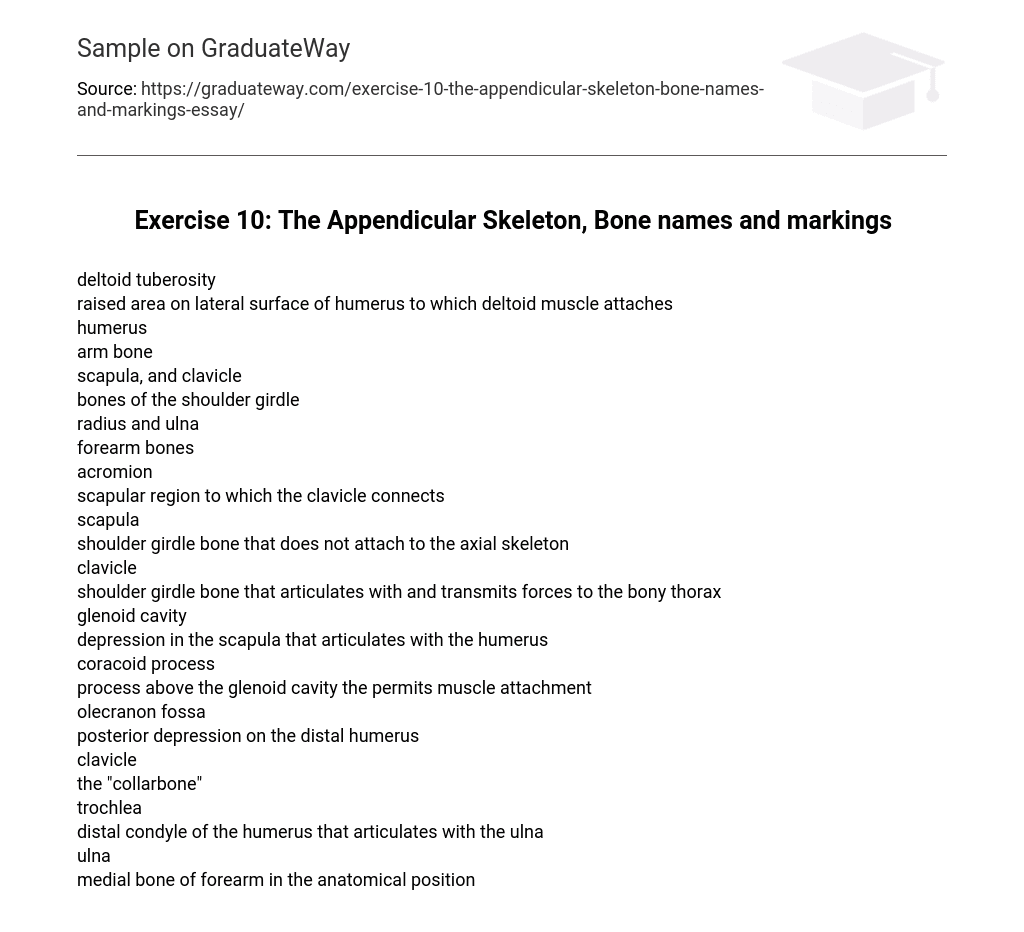deltoid tuberosity
raised area on lateral surface of humerus to which deltoid muscle attaches
scapula, and clavicle
bones of the shoulder girdle
radius and ulna
forearm bones
acromion
scapular region to which the clavicle connects
scapula
shoulder girdle bone that does not attach to the axial skeleton
clavicle
shoulder girdle bone that articulates with and transmits forces to the bony thorax
glenoid cavity
depression in the scapula that articulates with the humerus
coracoid process
process above the glenoid cavity the permits muscle attachment
olecranon fossa
posterior depression on the distal humerus
clavicle
the “collarbone”
trochlea
distal condyle of the humerus that articulates with the ulna
ulna
medial bone of forearm in the anatomical position
capitulium
rounded knob on the humerus; adjoins position
coronoid fossa
anterior depression, superior to the trochlea, that receives part of the ulna when the forearm is flexed.
radial notch
ulnar surface that articulates with the radial head
ulna
forearm bone involved in formation of the elbow joint
metacarpals
heads of these bones form the knuckles
medial epicondyle
small bump often caled the funny bone
scapula and sternum
bones that articulate with the clavicle
clavicle serves as an anterior base or strut to hold the arm away form the top of the thorax
how is the arm held clear of the widest dimension of the thoracic cage?
14
what is the total number of phalanges in the hand?
8
what is the total number of carpals in the wrist?
pisiform-triquetruml-lunate-scaphoid
name the carpals in the proximal row
trapezium- trapezoid- capitate- hamate
name the carpals in the distal row
flexibility and mobility
lightweight
insecure axial and limb attachments
describe the pectoral girdle
massive
secure axial and limb attachments
weight-bearing most important
describe the pelvic girdle
uterus, bladder, rectum, small intestines, and reproductive organs
what organs are protected, at least in part, by the pelvic girdle?
the true pelvis small bowl- like shape containing urinary bladder and sexual organs. false pelvis in between alla or wing of the pelvis is much larger and contains some abdominal organs like small intestine and colon.
distinguishing between the true pelvis and the false pelvis.
it is adapted for childbearing, defines birth control, farther apart than a males, sacrum is wider, shorter, and less curved than a males. brim is wider oval from side to side.
how do you know if a pelvis is a female pelvis?
the pelvic bones of humans have to carry his whole weight, divided by 2. 4 legged animals divide its weight by 4. since strain is less in 4 legged animals bones can be less massive.
deduce why the pelvic bones of a four legged animal such as the cat or pig are much less massive than those of the human.
to prevent a smaller target and to protect internal organs and genetalia
a person instinctively curls over his abdominal area in times of danger. why?
the angle of their hips turn legs slightly inward, making some actually touch at the knees
for what anatomical reason do many women appear to be slightly knock- kneed?
ilium, ischium and pubis
fuse to form the coxal bone
ischium
sit down bone of the coxal bone
pubic symphysis
point where the coxal bones (hip bones) join anteriorly
iliac crest
superiormost margin of the coxal bone
acetabulum
deep socket in the coxal bone that receives the head of the thigh bone
sacroiliac joint
joint between axial skeleton and pelvic girdle
femur
longest strongest bone in the body
fibula
thin lateral leg bone
tibia
heavy medial leg bone
femur, tibia
bones forming knee joint
tibial tuberosity
point where the patellar ligament attaches
medial malleolus
medial ankle projection
lateral malleolus
lateral ankle projection
calcaneus
largest tarsal bone
metatarsals
bones forming the instep of the foot
obturator foramen
opening in hip bone formed by th pubic and ischial rami
gluteal tuberosity and greater and lesser trochanters
site of muscle attachment on the proximal femur
talus
tarsal bone that sits on the calcaneus
tibia
weight-bearing bone of the leg
talus
tarsal bone that articulates with the tibia
Remember! This essay was written by a student
You can get a custom paper by one of our expert writers
Order custom paper
Without paying upfront

